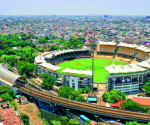95 years later, the Salt March lives on in Tamil Nadu, but the memory slips away – The Times of India

Every April 13 for the past 25 years, D. Sakthi Selvaganapathi, a horologist from Tiruvarur, makes his way to the Trichy cantonment. There, he joins fellow Gandhians for a 240 km salt march, reenacting the historic Vedaranyam Salt Satyagraha led by freedom fighter C. Rajagopalachari 95 years ago. Gandhians across Tamil Nadu have been reenacting the march for the past 60 years, says Selvaganapathi, ever since the 25th anniversary of the original walk.
“The reenactment is a reminder of breaking the salt law imposed by the British,” says the 71-year-old, who represents the Trichy-Vedaranyam Salt Satyagraha Dandi Yatra committee. “We continue to campaign against caste discrimination and alcoholism, advocate for literacy, and promote khadi, all causes that the Satyagrahis fought for in 1930.”
On March 12, 1930, Mahatma Gandhi led about 78 volunteers on a 387 km walk from Sabarmati Ashram in Ahmedabad to the coastal village of Dandi in Navsari district as part of the Civil Disobedience Movement. On April 6, at Dandi beach, Gandhi broke the salt law by boiling seawater to produce salt. Later, Rajagopalachari, President of the Tamil Nadu Congress Committee, began a 240 km march to Vedaranyam to replicate Gandhi’s protest. On April 13, 1930, 98 Satyagrahis started their journey from Dr T. S. S. Rajan’s residence near Trichy Cantonment.
The marchers walked through Srirangam, Kallanai, Thanjavur, Papanasam, Kumbakonam, Needamangalam, Mannargudi, and Thiruthuraipoondi, campaigning against caste discrimination and promoting national integration and social harmony. Despite threats of imprisonment from Thanjavur district collector J. A. Thorne, people in every village and town supported them.
“The sun did not rise over the Bay of Bengal on April 30 when CR and 16 fellow marchers set out towards Edanthevar salt swamp, a couple of miles from Vedaranyam camp. Almost immediately after they reached the swamp, they bent and picked up some salt,” writes Rajmohan Gandhi, author of the biography ‘Rajaji, a Life’. Rajagopalachari was immediately arrested. A trial was conducted at a salt shed (now the office of the salt commission in Agasthiyampalli). A judge sentenced Rajagopalachari to six months of rigorous imprisonment in Trichinopoly central prison. Following Rajagopalachari, hundreds of people defied the salt law in the following month and were arrested.
Every year, the Gandhians and Congress cadres dressed in khadi and carrying Indian flags from across Tamil Nadu reenact the march with a symbolic start at the same point near Trichy cantonment. The villagers of Vedaranyam and a group named Salt Satyagraha Reenactment Marchers Reception Committee welcome the reenactors as they arrive at Vedaranyam on April 28. The following day, the group holds a fast and sings songs of national devotion at the Vedaranyam Salt Satyagraha memorial, even spinning yarn on charkas.
On April 30, the Gandhians garland busts of Vedaranyam’s freedom fighters such as A. Vedaratnam, K. Vairappan, and V. Subbaiya, and grab handfuls of salt and raise slogans in front of the salt march memorial pillar in Agasthiyampalli where the salt laws were broken. “We are doing this in the hope that the younger generations will not forget,” says Selvaganapathi.
“Today’s generation is not aware of the significance of the Vedaranyam Satyagraha,” says ‘Pookadai’ T. Panneerselvam, a florist from Trichy and representative of the Salt Satyagraha Awareness Committee. “Though we Gandhians have been keeping the spirit of the Satyagraha alive with the reenactment, the govt too needs to promote awareness. The govt could develop memorials that educate people on this movement,” says the 61-year-old.
P. V. Rajendran, a representative of the Salt Satyagraha Reenactment Marchers Reception Committee, says names of Satyagrahis should be inscribed in memorials as people only know about Rajaji. “We can have sound and light shows at the memorials to educate students about it.”
Many historical sites associated with the movement are now dilapidated, says Selvaganapathi. “Dr T. S. S. Rajan’s house in Trichy and the historic buildings in Vedaranyam where the Satyagrahis were detained and tried after the salt march need renovation.” The family of Sardar Vedaratnam, who was one of the main figures of the Vedaranyam march, has been demanding statues of the freedom fighters for years now.
“We have been petitioning the Union govt to rename Agasthiyampalli Railway Station as ‘Salt Satyagraha Agasthiyampalli Railway Station’ and Vedaranyam Railway Station as ‘Sardar Vedaratnam Vedaranyam Railway Station’ for a few years now,” says his 74-year-old grandson A. Vedarathinam.
















